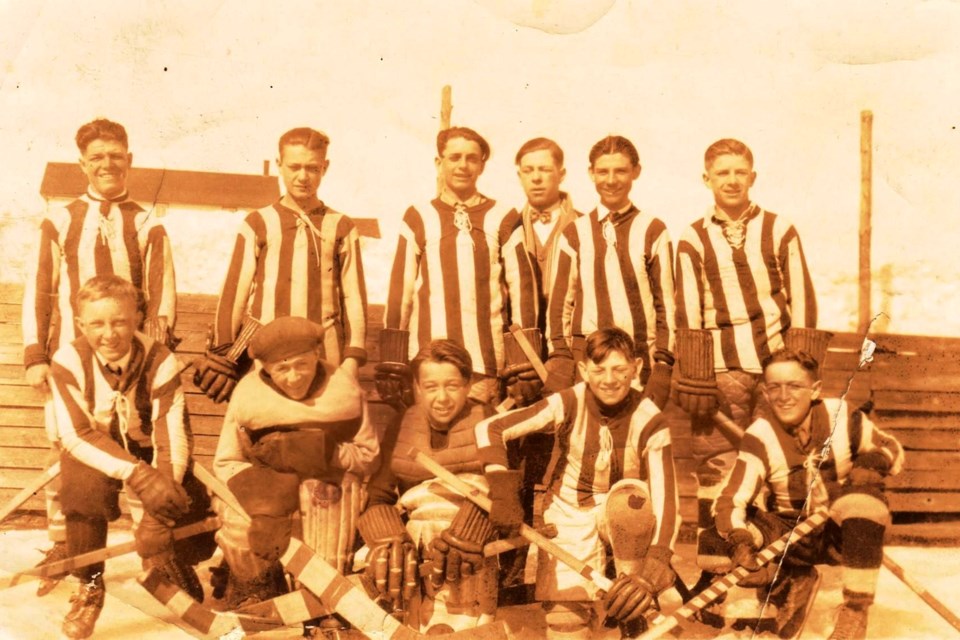For the previous 12 winters, your writer (along with a good group of volunteers) has been taking care of the outdoor rink in Coniston, making sure that the ice is up to snuff for both the youngsters dreaming of future glory and those oldsters who come out to dream of past glories.
On this night, my daughter, ever so shaky on her skates, staying both close to the boards and accelerating at as near to a turtle’s pace as possible, perhaps inspired by the boys playing hockey at the opposite end of the rink, asked me if I had a stick and puck for her to use. After handing her an old wooden Sherwood, dropping a puck with a faded Canadian Tire logo and watching her take the first tentative strides with puck on blade, my thoughts drifted to the past (as they often do) and I began to ponder the outdoor rink hockey of the past.
Now, if one sport were to be considered most identifiable and perhaps the absolute personification of Greater Sudbury, it would be that icy battle of the blades known as hockey.
Indeed, the feats of players and teams across both the amateur and the professional ranks have been major highlights of the area's athletic history. Most Sudburians can readily retrieve from their memory banks stories of provincial championships, Memorial and Allan Cups won, and hometown boys who made good in the National Hockey League.
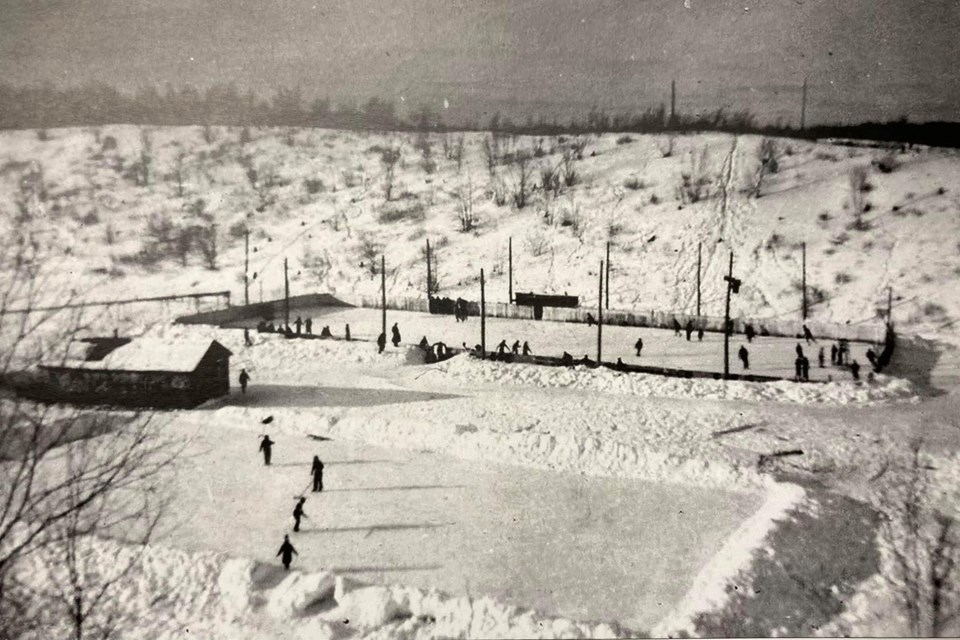
Over the years, hockey has brought together many thousands of people in search of athletic spectacle for which they have been rewarded by the excellence exhibited by players both big and small. For these reasons, hockey has remained Greater Sudbury's most popular sport.
The surveyor's error that shifted the path of our transcontinental railroad into the wealthy mineral deposits of the Sudbury Basin, had the effect of angling the steel rails through an expanse of Precambrian Shield surrounded by a myriad of creeks, rivers and more than 300 lakes.
So, when the harsh northern winters forced the residents into their months-long hibernation, those same frozen waters became the natural breeding ground for hockey players. Sudbury's pioneers found their recreational outlet in donning wooden skates and engaging in raucous games of shinny.
Entering its second decade of existence, the population of the village of Sudbury and the expanse of McKim Township that surrounded it, amounted to a little more than 2,000 people. It was only in the year 1892, that Sudbury was graced with the luxury of an indoor (covered but not heated) skating facility, known as Martin's Rink.
That winter, those who wished to play formed a club with the support of local businessmen, drawing the interest of 22 individuals. The first game of the season was part of the entertainment offered at a winter carnival, it was described as "an exciting hockey match."
However, we are here today to reminisce about the sport as played upon those less luxurious (though no less important) outdoor skating facilities of your local playground hockey rink. (We’ll come back to the indoor variety at a later date….)
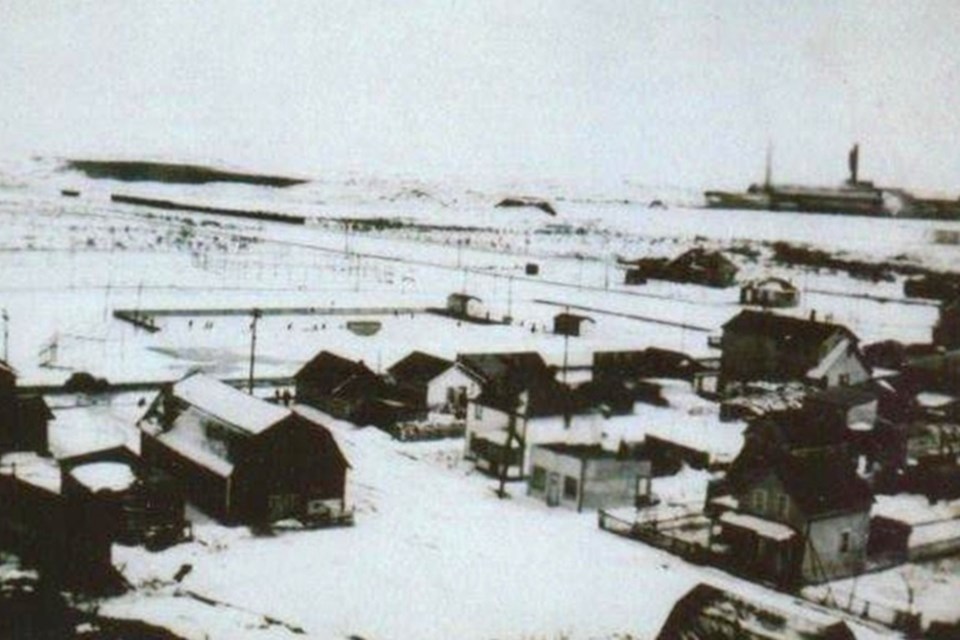
So, let us now button up our coats and move back outdoors …
As the years passed, the demand for outdoor winter recreational facilities increased across the Nickel Belt. In the mining and smelting centres of Coniston, Falconbridge, Levack and Creighton (among others), countless outdoor rinks were built for the leisure activities of the youngsters of their areas, most of whom were the children of the company workers.
In October 1955, 20 city playground rinks were planned for the coming winter, which continued an increase from previous years, based on growing popularity. City recreation director George Kormos said at the time, "The same playgrounds which had rinks last year will have them again, but we haven’t definitely decided on the other locations.”
The recreation director said requests were received from five home and school groups for school rinks. “We have ordered five new sets of rink boards this year.” At the time, the recreation department required that school and other non-playground rinks be requested and supervised by some responsible group.
Just a few months later, in early 1956, Nickel Belt was transformed into what was dubbed a “Kid Hockey Hotbed.” Youth hockey, with all the trappings and trimmings of the big leagues, right down to the team names (“Canadiens”, “Maple Leafs” and “Blackhawks”) enjoyed the distinction (unlike their professional namesakes) of boasting more players than spectators on most occasions. The myriad of leagues playing that year were blessed with plenty of cold weather and below-average snowfall so that the games were played with a minimum of delay.
A quick once-over of the multitude of teams in operation in the area at the time indicates that more than 2,000 boys from ages six to 16 were given the thrills and advantages of organized hockey. Many dedicated men devoted much of their leisure time to the cause, their material reward consisting solely of being permitted to clean off the rink after a heavy snowfall and between periods, and the privilege of buying the team pops and hot dogs after the game.
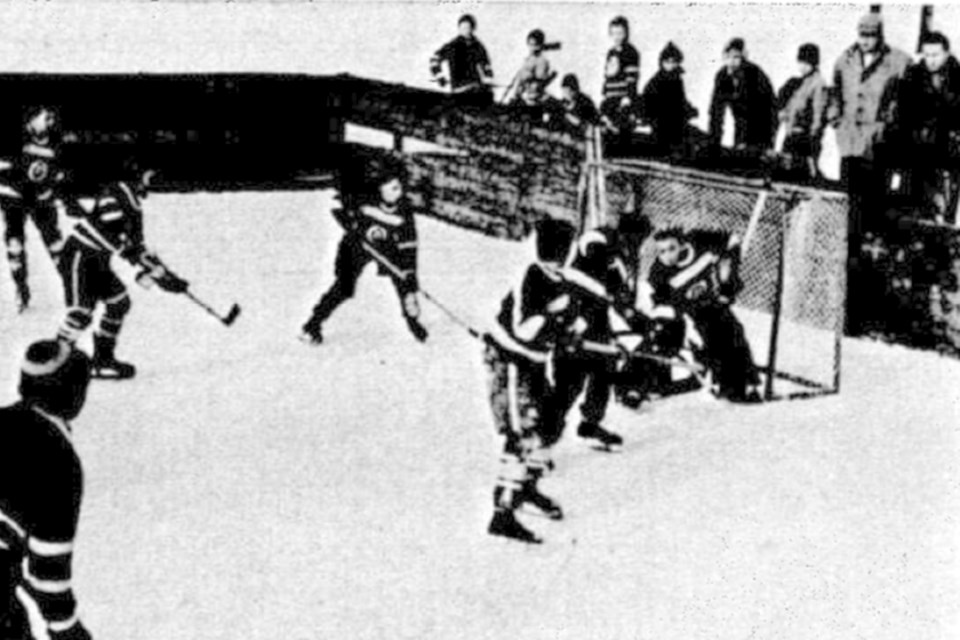
Playground hockey keeps growing
There was never any shortage of enthusiastic kids, but even then, it was reported that “the lack of volunteers willing to organize, control, encourage and coach the annual crop of potential hockey greats are, unfortunately, usually in short supply.”
At that time, what was known as the Sudbury Playground Hockey Association operated eight leagues from peewee through juvenile, with 38 teams in total. Games were played on the city playground rinks with George Kormos handling organization and details.
In Coniston, the local branch of the Royal Canadian Legion was behind the kids with their “little NHL” Bantam league consisting of teams named Black Hawks, Red Wings and Maple Leafs. As with most other leagues, the sticks, sweaters and pucks (but not the skates) were provided in addition to the goalie equipment.
A Midget team was also organized for fun and while not participating in an organized league they put in plenty of exhibition games. The two outdoor rinks used for hockey were provided to the town by INCO.
Two leagues were in operation at Creighton and Lively. The Suburban Playground League conducted peewee, minor bantam and bantam leagues, involving 14 teams playing at Creighton, Lively and Waters. A midget league was also in operation with entries from Creighton, Lively, Waters and Kelly Lake. The local schools were said to be most generous with their equipment and outdoor facilities for these leagues and their players.
In Sudbury, Safety Patrol Officer Archie Stewart even had a league going among the separate school patrol duty boys. The Schoolboy Patrols Hockey League as it was known comprised six teams from various separate schools with games being played on various playground rinks.
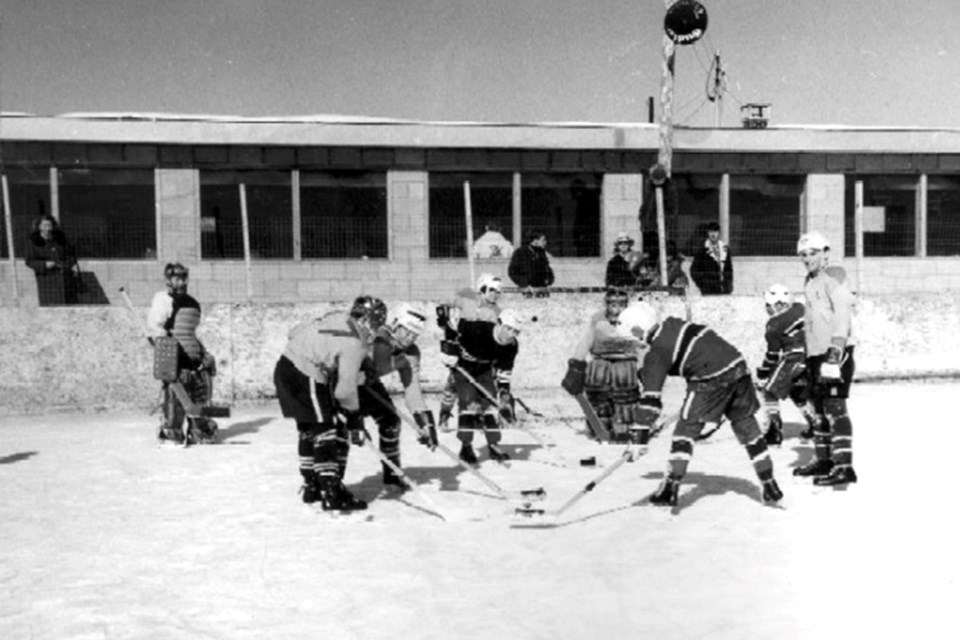
For the Winter of 1959, “little kids in big arenas" was the slogan of the Northern Ontario Playground Hockey Association, which was quite possibly the largest and certainly the most enthusiastic sporting endeavour in the North. Winding up their eighth season that year, officials of this organization claimed at the time that it had become “the largest hockey organization in the world.” In the Sudbury area alone, almost 1,500 boys played in this league, representing more than 75 teams.
In Sudbury, during the regular season games were played for the most part at outdoor playground rinks with only the finals played at Sudbury Arena. The association was allotted five hours' free ice time each Saturday at the arena giving each team a couple of chances at living the dream on the big ice.
When the playoffs arrived that year, Elm West defeated Capreol in the pee wee division, Kingsway topped Falconbridge in minor bantam, and Riverside bested Capreol in the major bantam division. This same trio of teams then went on to thrill the local fans with a triple triumph over the best that Sault Ste. Marie and the rest of the Sudbury district had to offer. In the NOPHA (unlike their minor hockey brethren), the presentation of individual trophies was forbidden as was commercial advertising. Again, Sudbury's recreation director George Kormas was an administrator of the association, with Tony DeMarco as the commissioner.
As the construction of indoor rinks across the Sudbury Region increased over the decades, the outdoor pond as the main location of organized hockey gradually decreased. However, that doesn’t mean that it ceased to exist entirely. Into the 1970s, the local playground hockey league still hosted six divisions across four age categories, including such teams as Cedar Park, Antwerp, Ridgecrest and Barrydowne.
In the 1980s, the Parks and Recreation Department of the city of Sudbury promoted the local playground winter carnivals (at O’Connor Park, Percy, Elm West and Rose-Marie, among others) where multiple battles of the blades would take centre stage. During the Antwerp winter carnival of 1982, the Antwerp squirt division even challenged Ryan Heights for city hockey supremacy (does anyone remember who came out on top?).
Now we return to the present, the boys at the opposite end of the rink from my daughter are still caught up in a rousing game of three-on-all (with no goalie). As I watch a poem I wrote 25 years ago for school comes to mind. In my mind's eye, the one in control of the puck has transformed and is now living the dream as so many of his forebears did, no longer on this neighbourhood rink but playing in the big time …
"There's no time left, it's all up to him,
The white knight wearing the colours of his team
Standing tall behind the security of the centre line.
He is engulfed in the roaring cacophony of the crowd
Which he knows will become solemn silence the minute he begins.
He stares intently at his opponent
The indomitable rock of Gibraltar - the goaltender.
Then the piercing sound of a whistle starts off his journey.
He glides down the ice with the puck;
The cool air strikes his tired face.
His blades churn up chips of ice.
He sways right,
Hesitates.
“It's now or never!'
Then stretches suddenly left,
Reaches,
Reaches farther,
Still farther,
He finally tucks the puck under the goalie's pads.
The puck dances for almost an eternity on the goal line.
Then the red light of victory ignites.
His journey is over; he can rest."
Well dear readers, while the players grab their shovels to clear the snow between periods (ain’t no Zambonis here), we would love to know your warmest memories of that coldest of sports as played on your neighbourhood playground rinks.
Tell us about the men and women who made it happen and the atmosphere of the games that you played. I’ve served up some wrist shot wisdom about playground hockey in the Sudbury region, now let’s see some memory rebound goals through the five-hole.
Jason Marcon is a writer and history enthusiast in Greater Sudbury. He runs the Coniston Historical Group and the Sudbury Then and Now Facebook page. Memory Lane is made possible by our Community Leaders Program.
